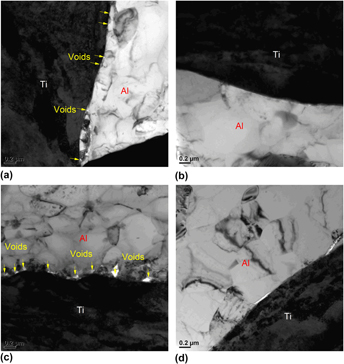Crossref Citations
This article has been cited by the following publications. This list is generated based on data provided by
Crossref.
Yu, Hailiang
Yan, Ming
Li, Jintao
Godbole, Ajit
Lu, Cheng
Tieu, Kiet
Li, Huijun
and
Kong, Charlie
2018.
Mechanical properties and microstructure of a Ti-6Al-4V alloy subjected to cold rolling, asymmetric rolling and asymmetric cryorolling.
Materials Science and Engineering: A,
Vol. 710,
Issue. ,
p.
10.
Yin, Xiaolong
Pi, Yunyun
He, Di
Zhang, Jiayang
and
Deng, Wenjun
2018.
Development of ultrafine grained Al 7075 by cryogenic temperature large strain extrusion machining.
Journal of Materials Research,
Vol. 33,
Issue. 20,
p.
3449.
Ghasali, Ehsan
Ali Nezhad, Mahdi Soltan
and
Ghazvinian, Sadegh
2019.
Preparation of Ti-based laminated composites through spark plasma sintering with different carbon sources as the bonding layer.
Ceramics International,
Vol. 45,
Issue. 11,
p.
14045.
WANG, Lin
DU, Qing-lin
LI, Chang
CUI, Xiao-hui
ZHAO, Xing
and
YU, Hai-liang
2019.
Enhanced mechanical properties of lamellar Cu/Al composites processed via high-temperature accumulative roll bonding.
Transactions of Nonferrous Metals Society of China,
Vol. 29,
Issue. 8,
p.
1621.
Yin, Xiaolong
Deng, Wenjun
Zou, Yinhui
and
Zhang, Jiayang
2019.
Ultrafine grained Al 7075 alloy fabricated by cryogenic temperature large strain extrusion machining combined with aging treatment.
Materials Science and Engineering: A,
Vol. 762,
Issue. ,
p.
138106.
Yin, Xiaolong
Chen, Haitao
and
Deng, Wenjun
2019.
Effects of Machining Velocity on Ultra-Fine Grained Al 7075 Alloy Produced by Cryogenic Temperature Large Strain Extrusion Machining.
Materials,
Vol. 12,
Issue. 10,
p.
1656.
Wang, Lin
Liu, Juan
Kong, Charlie
Pesin, Alexander
Zhilyaev, Alexander P.
and
Yu, Hailiang
2020.
Sandwich‐Like Cu/Al/Cu Composites Fabricated by Cryorolling.
Advanced Engineering Materials,
Vol. 22,
Issue. 10,
Chen, Haitao
Zhang, Baoyu
Zhang, Jiayang
and
Deng, Wenjun
2020.
Preparation of Ultrafine-Grained Continuous Chips by Cryogenic Large Strain Machining.
Metals,
Vol. 10,
Issue. 3,
p.
398.
Xiong, Hanqing
Su, Lihong
Kong, Charlie
and
Yu, Hailiang
2021.
Development of High Performance of Al Alloys via Cryo‐Forming: A Review.
Advanced Engineering Materials,
Vol. 23,
Issue. 6,
Yu, Hai Liang
Liu, Juan
and
Wang, Lin
2021.
Improvement of Mechanical Properties of Laminated Composites by Using Cryogenic Roll Bonding.
Materials Science Forum,
Vol. 1016,
Issue. ,
p.
1696.
Gao, Haitao
Li, Jing
Lei, Gang
Song, Lingling
Kong, Charlie
and
Yu, Hailiang
2022.
High Strength and Thermal Stability of Multilayered Cu/Al Composites Fabricated Through Accumulative Roll Bonding and Cryorolling.
Metallurgical and Materials Transactions A,
Vol. 53,
Issue. 4,
p.
1176.
Luo, Kaiguang
Xiong, Hanqing
Zhang, Yun
Gu, Hao
Li, Zhide
Kong, Charlie
and
Yu, Hailiang
2022.
AA1050 metal matrix composites reinforced by high-entropy alloy particles via stir casting and subsequent rolling.
Journal of Alloys and Compounds,
Vol. 893,
Issue. ,
p.
162370.
Yan, Qianyun
Fan, Qunbo
Yang, Suyuan
Yang, Lin
Wang, Duoduo
Gong, Haichao
Xu, Shun
Yuan, Jingjiu
Shen, Xinyu
and
Geng, Naitao
2022.
Influential mechanisms on interface bonding of hot-rolled TB9/TC4 laminated composites.
Materials Science and Engineering: A,
Vol. 853,
Issue. ,
p.
143749.
Vijayakumar, M.
Pradeep Rai, M.
Muthukrishnan, M.
and
Gnanakumar, N.
2022.
Stir Casting and Successive Rolling of Aluminium Alloy 2218 MMCs Reinforced by High-Entropy Alloy Particles.
Key Engineering Materials,
Vol. 935,
Issue. ,
p.
151.
Song, Lingling
Xie, Zhibao
Gao, Haitao
Kong, Charlie
and
Yu, Hailiang
2022.
Microstructure and mechanical properties of ARB-processed AA1050/AA5052 multilayer laminate sheets during cryorolling.
Materials Letters,
Vol. 307,
Issue. ,
p.
130998.
Liu, Qiang
Liu, Ying
Luo, Qing
Song, Jiangfeng
Xiao, Biquan
Jiang, Bin
Wu, Liangyin
Zhao, Hua
Shen, Qiuyan
and
Pan, Fusheng
2023.
Ameliorating the edge cracking behavior of Mg-Mn-Al alloy sheets prepared by multi-pass online heating rolling.
Journal of Manufacturing Processes,
Vol. 85,
Issue. ,
p.
977.
LI, Zixuan
REZAEI, Shahed
WANG, Tao
HAN, Jianchao
SHU, Xuedao
PATER, Zbigniew
and
HUANG, Qingxue
2023.
Recent advances and trends in roll bonding process and bonding model: A review.
Chinese Journal of Aeronautics,
Vol. 36,
Issue. 4,
p.
36.
Wang, Yumeng
Du, Jinlong
and
Xiao, Hong
2023.
Interfacial evolution and coordinated deformation mechanism of Ti/Al laminated metal composites prepared by diffusion bonding.
Journal of Materials Research and Technology,
Vol. 27,
Issue. ,
p.
4541.
GAO, Hai-tao
KONG, Charlie
and
YU, Hai-liang
2023.
Lightweight metal laminated plates produced via (hot, cold and cryogenic) roll bonding: A review.
Transactions of Nonferrous Metals Society of China,
Vol. 33,
Issue. 2,
p.
337.
Yang, Shisen
Li, Zhide
Zhou, Yuexin
Tan, Zeng
Kong, Charlie
and
Yu, Hailiang
2023.
Edge-crack free and high mechanical properties of AA7075 sheets by using cryorolling and subsequent aging.
Journal of Alloys and Compounds,
Vol. 931,
Issue. ,
p.
167556.
